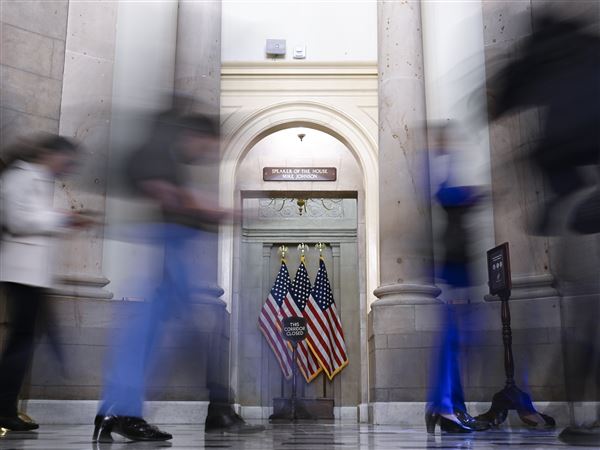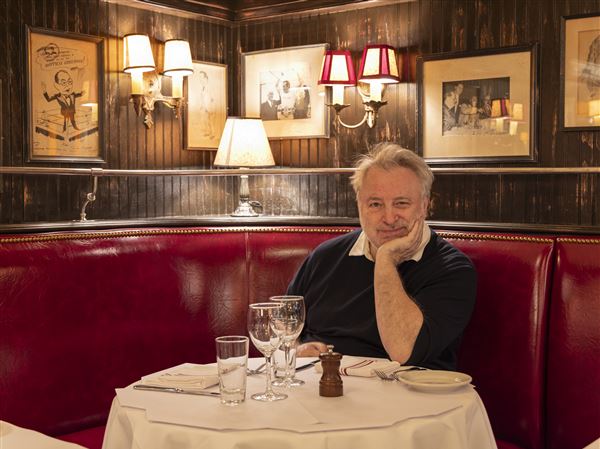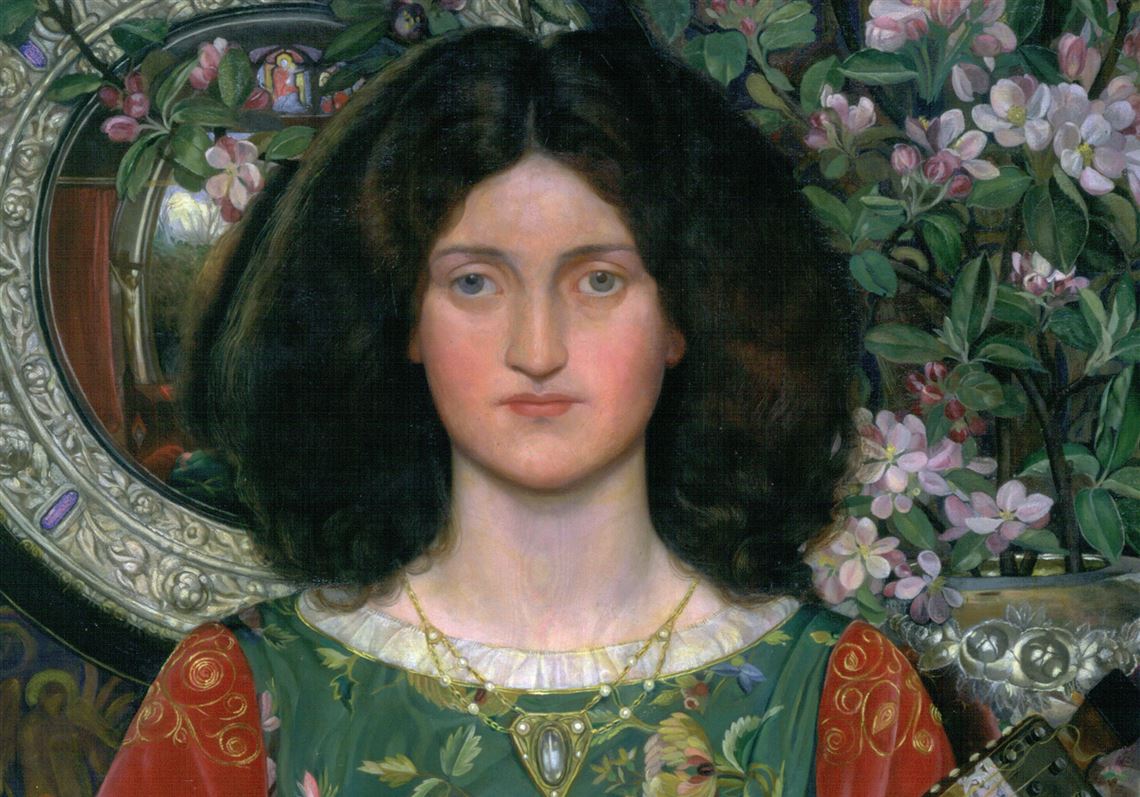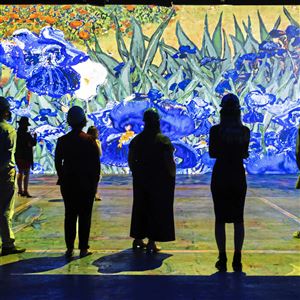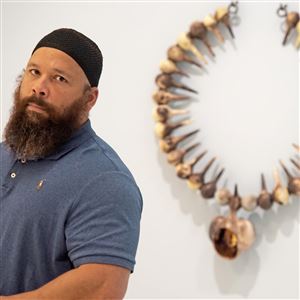A trio of daring English artists founded the Pre-Raphaelite Brotherhood in 1848, calling for a return to the clarity, detail and honesty that characterized European painting in the 1400s.
These men — Dante Gabriel Rossetti, John Everett Millais and William Holman Hunt — embraced nature in all its lushness along with Bible stories and complex composition. The dramatic rise of industry and factories all over England prompted them, and some of their colleagues, to seek inspiration from the pre-industrial past.
The vibrant canvases on view at The Frick Pittsburgh through Jan. 30 are exceptionally notable for their jewel tones and passionate emotions. The exhibition is “Victorian Radicals: From The Pre-Raphaelites To The Arts & Crafts Movement.”
Paintings in one of the museum’s permanent galleries were removed to make room for this show of more than 100 artworks from the city of Birmingham, England. Many have never left England before. One example is a painted gilded Italian bridal chest that shows Edward Burne-Jones’ fascination with the Italian Renaissance.
Dawn R. Brean, chief curator and director of collections, said the Pre-Raphaelites believed in art as a force for social good.
The Pre-Raphaelites represented the first of three rebellious generations of craftspeople, designers and painters who valued the handmade over factory-made goods. A second generation of Pre-Raphaelites blossomed in the late 1850s, including Elizabeth Siddall, a gifted artist who became Rossetti’s model, muse and wife.
A third wave, the Arts & Crafts movement, produced books that were works of art, such as the Kelmscott Chaucer, hand-blown glass, embroidery, jewelry, stained glass, tapestries, tiles and elaborately patterned wallpaper. Stellar examples of each are featured in this exhibition, creating a richly textured visual feast.
The show opens with Kate Elizabeth Bunce’s painting, “Musica,” a portrait of a woman playing a lute and attired in a red and green dress. New synthetic dyes, available by the 1850s, offered artists a palette of vivid greens, pinks and purples.
“Pretty Baa-Lambs,” painted outdoors by Ford Madox Brown, shows his future wife, Emma, and their young daughter, Catherine, in a field with grazing lambs that are so realistic you’ll want to pet them.
Brown’s colleague, William Holman Hunt, captured a scene filled with sexual tension in “Two Gentlemen of Verona.” Inspired by a scene from Shakespeare’s play, the painting shows Valentine rescuing Sylvia from the sexual advances of Proteus.
From 1854 to 1856, Hunt lived in Jerusalem, where he produced “The Finding of the Saviour in the Temple.” One of the most ambitious religious paintings of the 19th century, it shows Joseph and Mary discovering a young Jesus, dressed in a purple robe, talking with rabbis.
In 1857, Rossetti organized a team of painters to decorate the walls of the Oxford Union Society’s debating chamber. With scenes of King Arthur and his quest for the Holy Grail, the project launched the second wave of Pre-Raphaelites. Participants included William Morris and Bourne-Jones, who became key leaders of the Arts & Crafts movement.
A portrait of Rossetti by Hunt shows a man with a luminous face and glowing blue eyes, conveying his rebellious charisma. At his home in London, Rossetti welcomed many young artists, including Frederick Sandys and Simeon Solomon.
Sandys painted two of this exhibition’s showstoppers: “Medea” and “Morgan le Fay.”
After her lover, Jason, deserts her for a princess, an enraged Medea plots revenge on her rival, preparing a spell with blood, a dried stingray, a deadly plant called nightshade and two mating toads. Not to be outdone, Morgan le Fay, the half-sister of King Arthur, plots to murder him by weaving an enchanted garment designed to set him on fire. In the painting, she casts a spell on the deadly robe.
Solomon’s sexy portrait of a handsome Bacchus shows the god of wine as an androgynous youth with a sensuous mouth. The portrayal was subversive because Bacchus symbolized hedonism and bisexuality in the 1800s.
Five years after painting the portrait, Solomon was arrested in a public lavatory with another man and convicted of indecency. He continued working, and his drawings were admired by Oscar Wilde and his followers, who appreciated the illicit poetic nature of his work.
One piece of jewelry shows how far an artist will go to express love for his new wife. Another reveals the ambitions of designers to tell a story. .
George James Frampton, a successful sculptor who created many statues of Queen Victoria, also was a pioneer of art jewelry. In 1893, he used silver gilt, champleve enamel, pearls and opals to create a necklace for his bride, Christabel Cockerell.
The Ariadne Necklace, made in 1905, is the work of Edward Spencer and John Bonner, both trained as architects. The duo made some of the most ambitious jewelry of the 20th century. The gold and diamond necklace shows Ariadne, the Cretan princess who helped her lover, Theseus, to defeat the Minotaur. Theseus abandoned Ariadne on the island of Naxos and the ships in the necklace represent his fleet sailing for home. Dionysus, the god of wine, rescues Ariadne, who stands above the waves, flanked by Eros and Aphrodite.
Admission to “Victorian Radicals” is $15 for adult non-members; $13 for seniors and students; $8 for youth ages 6-16. Frick members and children 5 and under are admitted free. For tickets or more information, call 412-371-0600 or go to www.thefrickpittsburgh.org.
Marylynne Pitz is a Pittsburgh-based arts journalist. Contact her at mlpitz27@gmail.com.
First Published: November 15, 2021, 11:00 a.m.
Updated: November 15, 2021, 11:56 a.m.




